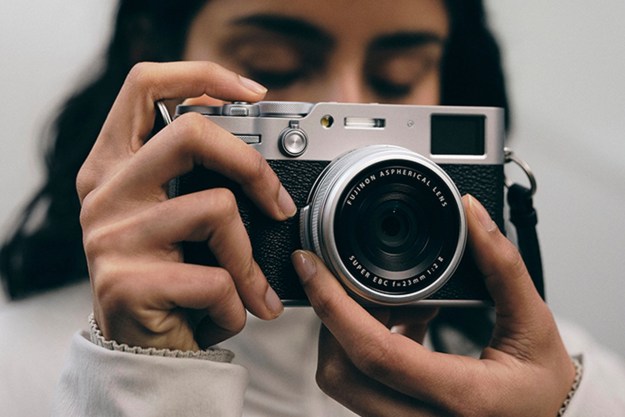
When purchasing a digital camera, there are the usual specs that all buyers need to keep in mind: sensor, resolution, optical zoom lens, image stabilization, etc. But what about the extra features that manufacturers add to their products to entice you to buy theirs and not the others? How important is it to have these features included in your next purchase? We’ve highlighted a few of these new (and newish) digital camera features to help you decide which to put on your checklist, and which to cross off.
Back-Illuminated CMOS Sensor

What is it: A sensor converts the light a camera captures into a digital signal. A traditional CMOS sensor has wiring on the front that delivers the signal from each tiny pixel – the pixels are what capture light that enters the lens. In a back-illuminated CMOS sensor, also known as BI or BSI CMOS, the wiring is moved to the back of the sensor. This increases light sensitivity, as the pixels are exposed to more light. Sony has been using its Exmor R BI CMOS sensor since 2009, while smartphones like the iPhone also utilize this type of sensor.
Is it important: Yes. Several new cameras and camcorders featuring BI CMOS sensors were unveiled at CES. Larger sensors can capture more light, but compact cameras can’t accommodate large sensors due to form factor. BI CMOS helps in that capacity. Expect to see more BI CMOS sensors in cameras moving forward.
Full HD

Is it important: Depends. For most users, video is still a bit of a novelty. It’s nice to know it’s there, but not all cameras can handle video capture well. If you’re serious about shooting video, check out a dedicated camcorder or POV “sport” camcorder, or a DSLR with strong video capture capability.
Hybrid AF
What is it: A hybrid autofocus system combines phase detection AF and contrast AF. Traditional phase detection AF, used by DSLRs, splits light into two images, compares them, and tells the system what is or what is not in focus; the system then adjusts accordingly. This all happens very quickly, but isn’t as accurate as contrast AF, nor does it work in live-view mode. Contrast AF, used by compact and mirrorless cameras, measures contrast off the sensor, so it’s more accurate than phase detection and works in live view. The downside is that it’s much slower and doesn’t handle motion well. A hybrid of the two allows for faster autofocusing.
Is it important: Yes. Slow autofocus can dampen the photo-taking experience, especially if you’ve just dropped a ton on a mirrorless interchangeable lens camera. Anything to speed up a camera will be welcome down the line.
Ruggedness

What is it: Waterproof, dust proof, freeze proof, shock proof – all these “proofs” are what make rugged cameras unique. They are designed to take a beating in all types of elements. Great for “active” users who enjoy taking cameras to places like the beach or snow-covered mountain.
Is it important: Depends. If you aren’t heading into the jungles of the Amazon, most of us don’t need the hardy casing of this type of camera. The accident prone, however, may benefit from the sturdiness. In the past, users have had to trade performance for the rugged features, but the newest models from Olympus, for example, show that you can have a tough camera that functions well.
3D

What is it: Unless you were just transported into the 21st century from Ancient Rome, this is self-explanatory. If you’ve been to the movies in the past few years or have ridden the Captain EO ride at Disneyland, 3D – stereoscopy – is the technique for creating depth (or the illusion of it, rather) in an image or video, making it seem like an element within the image is popping out at you. Simply put: Two images of the same point are taken at different distances, and combined to create a 3D image.
Is it important: No. Remember how 3D TVs were all the rage a couple years ago? Well, they barely made a peep at this year’s CES (if it did, our apologies, but we were probably gawking at 4K resolution). The problem is that 3D is neat in certain occasions, but it’s hokey in others. You need special equipment like 3D-capable TVs and 3D glasses to display it, and they aren’t cheap. Nobody is buying a new TV just to have 3D, but 3D is a nice bonus if it’s included, whether they use it or not.
One problem with 3D is that the adoption rates aren’t there, although the CEA recently told Variety that it’s increasing. But the biggest problem is the availability of content, or lack of. We are super-psyched about Samsung’s new NX300 Smart Camera, which has the ability to capture 3D images and video through a special lens, but for us that isn’t the camera’s main selling point. Tormenting your guests by having them watch your vacation photos and videos is one thing, but asking them to use special equipment to view them is crossing the line.
Touchscreen
What is it: Taking a page from smartphones, camera companies are adding touch-functionality to the LCD. Instead of navigating menus through physical buttons, users can easily select items by pressing on the screen. And, by moving all the functions to the screen, manufacturers can streamline the number of buttons on a camera and allow for a larger LCD.
Is it important: Depends, but we are leaning toward no. Adding a touchscreen without good software that actually takes advantage of it is a waste. In addition to being responsive and easy to use, there should be a reason for using a touchscreen, i.e. making the camera easier to operate. Call us old school, but we find dials and physical buttons quicker for settings adjustments. Being able to press onscreen to select things is fine or when you need to type in passwords for Wi-Fi pairing, for example, but when it’s used to control all aspects of the camera, as we found with the Canon EOS M, it can be a hindrance.
Wi-Fi
What is it: As you probably already know, Wi-Fi is a connectivity protocol that lets devices talk to one another or a network wirelessly. Once common with computers, Wi-Fi is now found in smartphones, portable gaming consoles, and refrigerators, and Wi-Fi hotspots are located throughout the country. As a way to compete with the instant gratification provided by smartphones, camera makers are baking Wi-Fi connectivity into their shooters so you can share pictures without the need for a PC.
Is it important: Depends. One of the challenges facing camera makers in this battle against smartphones is connectivity. As the growth in smartphone photography has shown, the ability to share photos instantly is a highly desirable feature – for some, sharing is even more important than the picture quality. The problem is that, unlike smartphones that are constantly connected, Wi-Fi-enabled cameras require a “bridge” to upload those photos, which could be an open wireless network or a smartphone (the cruel irony). Even then, some cameras require you to access another proprietary service for uploading photos before you can send them directly to Facebook or e-mail. In these cases, having Wi-Fi in your camera just isn’t worth it.
One trend we could see more of is the use of Android in cameras, like Samsung’s Galaxy EK-GC100, Nikon’s S800c, and the upcoming Polaroid iM1836, which lets users upload their photos directly to the Web. Connectivity itself is important, and if digital camera makers can finally get it right, it has the potential to become a useful feature.
About Android: With two products out, Samsung and Nikon are testing the waters with their Android-based cameras. Eschewing the often-difficult user interfaces that are implemented in cameras, the cameras utilize a GUI that’s familiar with the fast-growing smartphone-carrying population. But with only two models on the market and so-so image quality, it’s too early to tell if this is inevitable trend or fad.
NFC
What is it: Ever tap a card to gain access into a room, pay for groceries, or ride the subway? That’s near-field communication, or NFC, a short-range wireless technology. Whether embedded into a credit card or smartphone, NFC transfers data only at very short ranges, hence the “tapping.” Besides payment and entry, there are other uses for it, as well.
Is it important: No. At CES this year, companies like Panasonic demonstrated NFC in a few of their new products, including cameras and camcorders. The concept is that you can connect a camera to a NFC-enabled television or smartphone by tapping the devices together, for example, which allows you to send images back and forth. But, as with 3D, adoption levels for NFC aren’t there, yet. Unlike Europe or Asia where NFC usage has been prevalent, the U.S. hasn’t embraced it. Plus, there are few products supporting the protocol now; even if you have NFC in your camera, what would you use it with? Perhaps NFC will make a bigger splash down the road, but as of now, don’t worry if your new camera purchase lacks this feature.
Are there digital camera features you were excited about, only to be disappointed when you used them? Share in the comments.
(Update: In our original article, we stated that the Canon PowerShot N can upload content directly to social media sites. The camera still requires a connection to a smartphone to do that.)


